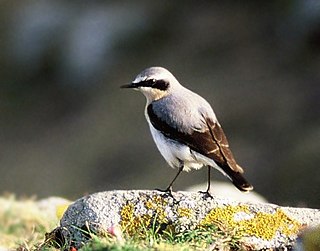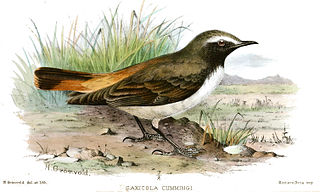
The wheatears are passerine birds of the genus Oenanthe. They were formerly considered to be members of the thrush family, Turdidae, but are now more commonly placed in the flycatcher family, Muscicapidae. This is an Old World group, but the northern wheatear has established a foothold in eastern Canada and Greenland and in western Canada and Alaska.

The isabelline wheatear is a small passerine bird that was formerly classed as a member of the thrush family Turdidae, but is now more generally considered to be an Old World flycatcher in the family Muscicapidae. It is a migratory insectivorous bird. Its habitat is steppe and open countryside and it breeds in southern Russia and Central Asia to northern Pakistan, wintering in Africa and northwestern India. It is a very rare vagrant to western Europe.

The desert wheatear is a wheatear, a small passerine bird that was formerly classed as a member of the thrush family Turdidae, but is now more generally considered to be an Old World flycatcher (Muscicapidae). It is a migratory insectivorous species, 14.5 to 15 cm in length. Both western and eastern forms of the desert wheatear are rare vagrants to western Europe. The western desert wheatear breeds in the Sahara and the northern Arabian peninsula. The eastern race is found in the semi-deserts of Central Asia and in winter in Pakistan and northeast Africa.

The western black-eared wheatear is a wheatear, a small migratory passerine bird that was formerly classed as a member of the thrush family Turdidae, but is now considered to be an Old World flycatcher. It was formerly considered conspecific with the eastern black-eared wheatear.

The pied wheatear is a wheatear, a small insectivorous passerine bird that was formerly classed as a member of the thrush family Turdidae, but is now more generally considered to be an Old World flycatcher. This migratory central Asiatic wheatear occurs from the extreme southeast of Europe to China, and has been found wintering in India and northeastern Africa. It is a very rare vagrant to western Europe.

The yellow-legged buttonquail is a buttonquail, one of a small family of birds which resemble, but are unrelated to, the true quails. This family is peculiar in that the females are larger and more colourful than the males and are polyandrous.

The chestnut-bellied sandgrouse or common sandgrouse is a species of sandgrouse. It is a sedentary and nomadic species that ranges from northern and central Africa and further east towards western and southern Asia. There are six recognised subspecies.

The white-headed buffalo weaver or white-faced buffalo-weaver is a species of passerine bird in the family Ploceidae native to East Africa. The buffalo part of its name derives from its habit of following the African buffalo, feeding on disturbed insects. Two subspecies are recognized.

The red-rumped wheatear or buff-rumped wheatear is a species of bird in the family Muscicapidae. It is found in North Africa and the Middle East.

The Kurdish wheatear, also known as the Kurdistan wheatear, the chestnut-rumped wheatear or the red-rumped wheatear, is a species of bird in the family Muscicapidae. The red-tailed wheatear was formerly considered a subspecies of this bird but is now often regarded as a separate species. The two may intergrade in Iran but it is also possible that the rather differently coloured cummingi is in fact a one-year-old O. xanthoprymna with intermediate plumage.

The red-tailed wheatear, also known as the rusty-tailed wheatear, Persian wheatear or Afghan wheatear, is a small passerine bird breeding in mountainous areas of south-west and central Asia. It belongs to the wheatear genus Oenanthe which was formerly placed in the thrush family Turdidae but is now in the Old World flycatcher family Muscicapidae. The red-tailed wheatear used to be considered a subspecies of the Kurdish wheatear but is now often regarded as a separate species.

Heuglin's wheatear is a small passerine bird in the wheatear genus Oenanthe.

The Tsavo sunbird is a small passerine bird of Kenya and Tanzania. It is sometimes lumped with the purple-banded sunbird.
Sharpe's rosefinch is a species of finch in the family Fringillidae. It is found in central China and far northern Myanmar. Its natural habitat is subtropical or tropical high-altitude shrubland. It was formerly considered to be a subspecies of the spot-winged rosefinch.

The eastern black-eared wheatear is a wheatear, a small migratory passerine bird that was formerly classed as a member of the thrush family Turdidae, but is now considered to be an Old World flycatcher. It was formerly considered conspecific with the western black-eared wheatear.

The black bishop is a species of passerine bird in the family Ploceidae native to Africa south of the Sahara. Three subspecies are recognised.

The Atlas wheatear, also known as the black-throated wheatear or Seebohm's wheatear, is a small passerine bird which breeds in the Maghreb region of North Africa and winters in the western Sahel. It was formerly considered a subspecies of the northern wheatear as O. o. seebohmi, but was reclassified as a distinct species by the IOC in 2021.

















